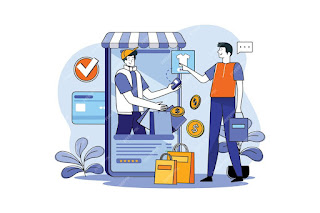How to Launch Your Own Peer-to-Peer Marketplace Platform
Peer-to-peer (P2P) marketplaces have become a well-liked and efficient means of bringing buyers and sellers together directly in the era of the sharing and sharing economies. P2P markets have the potential to be extremely profitable, as demonstrated by platforms such as eBay, Airbnb, and Uber. This extensive tutorial will lead you through the essential procedures and factors to help you get started if you're thinking about starting your own P2P marketplace platform.
Understanding the Peer-to-Peer Marketplace
Peer-to-peer marketplaces are online marketplaces where users can transact with one another directly for goods and services. P2P marketplaces enable transactions between individuals, as opposed to standard e-commerce sites, which frequently entail transactions between firms and consumers. Numerous industries, such as real estate, transportation, freelancing services, and second-hand goods, can use this concept.
Step 1: Identify Your Niche
Finding a niche is a necessary first step in starting a profitable P2P platform. If there is a particular market demand or issue that is not sufficiently addressed by current solutions, your platform should address it. To comprehend the needs, inclinations, and problems of your target market, do in-depth market research. Take into consideration these inquiries:
What specific market or community will your platform serve?
What unique value will your platform provide?
Who are your potential competitors, and how will you differentiate your platform from theirs?
Choosing a niche not only helps in targeting your marketing efforts but also ensures that your platform has a clear value proposition.
Step 2: Develop a Business Plan
A solid business plan is essential for guiding the development and growth of your P2P marketplace. Your business plan should include:
Market Analysis: Insights into your target market and competitive landscape.
Value Proposition: A clear statement of the unique benefits your platform will offer.
Revenue Model: Strategies for generating income, such as transaction fees, subscription fees, or advertising.
Marketing and Sales Strategy: Plans for attracting and retaining users.
Operational Plan: Details on how the platform will function, including technology, logistics, and customer support.
Financial Projections: Estimates of your startup costs, revenue, and profitability.
Step 3: Choose the Right Technology
The technology stack you choose for your P2P marketplace will significantly impact its performance, scalability, and user experience. Here are some key considerations:
Platform Type:Decide on whether to develop a mobile app, a web platform, or both. Multi-platform options are provided by numerous prosperous P2P marketplaces.
Frameworks and Tools: Use frameworks like Django, Node.js, or Ruby on Rails for web development. React Native or Flutter can assist you in developing cross-platform mobile applications.
Hosting and Scalability: Select a dependable hosting company that can grow with your platform, such as AWS, Google Cloud, or Azure.
Security:Put strong security measures in place to safeguard user information and guarantee secure transactions.
Step 4: Design and User Experience
An intuitive and engaging user experience (UX) is crucial for the success of your P2P marketplace. Focus on the following design aspects:
User Interface (UI): Ensure your platform has a clean, user-friendly interface that makes navigation easy.
User Journey: Map out the user journey from registration to transaction completion. Simplify processes like listing products, searching for items, and making payments.
Responsive Design: Ensure your platform is responsive and works well on various devices and screen sizes.
Feedback Mechanisms: Implement features for ratings, reviews, and feedback to build trust and improve the user experience.
Step 5: Building Trust and Safety
Trust is a cornerstone of any successful P2P marketplace. Implement features that promote safety and security, such as:
Verification Processes: Use email or phone verification to authenticate users.
Secure Payment Systems: Integrate secure payment gateways to protect financial transactions.
Ratings and Reviews: Allow users to rate and review each other to build a reputation system.
Dispute Resolution: Clearly defined procedures should be in place to settle user issues.
Step 6: Launch and Marketing
With your platform ready, it’s time to launch and attract users. Here are some strategies:
Soft Launch: To get feedback and make the required changes, start with a soft launch to a limited audience.
Digital Marketing: To reach your target demographic, make use of PPC advertising, social media, SEO, and content marketing.
Community Engagement: Use social media groups, online forums, and online communities to interact with potential users.
Promotions and Incentives: Encourage users to sign up and use your platform by offering discounts, promotions, or referral benefits.
Step 7: Monitor and Iterate
Once your P2P marketplace has been set up, keep an eye on user comments and its performance.
To monitor important indicators like customer satisfaction, transaction volume, and user engagement, use analytics tools. Prepare yourself to make adjustments and iterations in response to the information and input you gather.
Conclusion
Establishing a peer-to-peer marketplace platform is a challenging but worthwhile project. You may create a platform that effectively connects people and serves their requirements by focusing on user experience and trust, selecting the appropriate technology, creating a thorough business plan, and defining a niche. In the rapidly changing digital economy, your P2P marketplace might grow into a worthwhile project with proper planning and execution.


Comments
Post a Comment